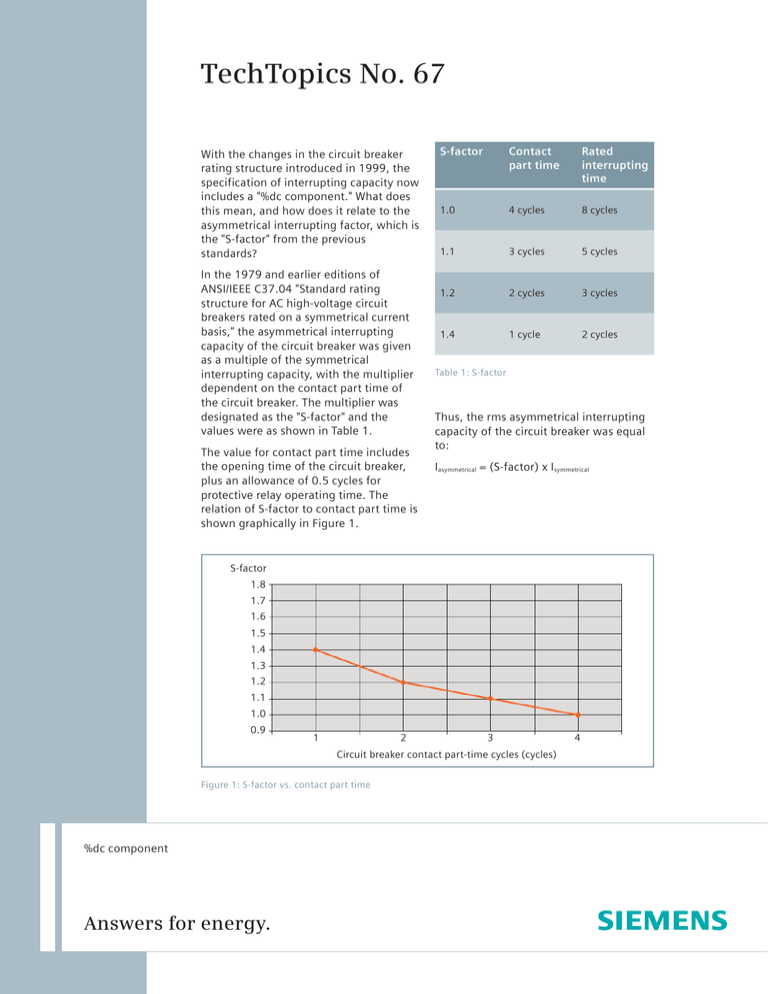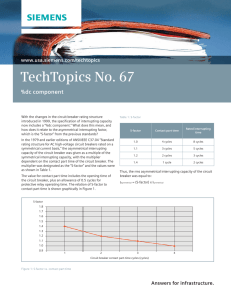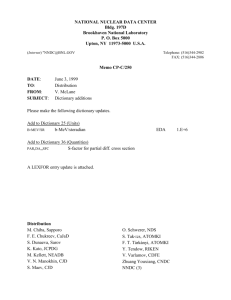
TechTopics No. 67
With the changes in the circuit breaker
rating structure introduced in 1999, the
specification of interrupting capacity now
includes a "%dc component." What does
this mean, and how does it relate to the
asymmetrical interrupting factor, which is
the "S-factor" from the previous
standards?
In the 1979 and earlier editions of
ANSI/IEEE C37.04 "Standard rating
structure for AC high-voltage circuit
breakers rated on a symmetrical current
basis," the asymmetrical interrupting
capacity of the circuit breaker was given
as a multiple of the symmetrical
interrupting capacity, with the multiplier
dependent on the contact part time of
the circuit breaker. The multiplier was
designated as the "S-factor" and the
values were as shown in Table 1.
The value for contact part time includes
the opening time of the circuit breaker,
plus an allowance of 0.5 cycles for
protective relay operating time. The
relation of S-factor to contact part time is
shown graphically in Figure 1.
S-factor
Contact
part time
Rated
interrupting
time
1.0
4 cycles
8 cycles
1.1
3 cycles
5 cycles
1.2
2 cycles
3 cycles
1.4
1 cycle
2 cycles
Table 1: S-factor
Thus, the rms asymmetrical interrupting
capacity of the circuit breaker was equal
to:
Iasymmetrical = (S-factor) x Isymmetrical
S-factor
1.8
1.7
1.6
1.5
1.4
1.3
1.2
1.1
1.0
0.9
1
2
3
Circuit breaker contact part-time cycles (cycles)
Figure 1: S-factor vs. contact part time
%dc component
Answers for energy.
4
Using an example circuit breaker rated
40 kA with a contact part time of 2.0
cycles, the asymmetrical interrupting
capability would be 1.2 x 40 kA = 48 kA,
under the rating structure of
C37.04-1979.
In 1999, the new "constant kA" rating
structure was introduced, and
determining the asymmetrical
interrupting capacity became a bit more
difficult.
S-factor
(old)
Equivalent
%dc
component
1.4
69.3%
1.2
According to ANSI/IEEE C37.04-1999,
clause 5.8.2.2, the asymmetrical
interrupting capacity is calculated from
the following equations:
Iasymmetrical = Isymmetrical
√1+2 (%dc/100)
2
%dc = 100e(-t/45)
where t is the contact part time of the
circuit breaker (including ½-cycle relay
time). The value of "45" in the
denominator of the exponent is the
circuit time constant of 45 ms, which is
the time constant of decay of the dc
component in a circuit with an X/R ratio
of 17 on a 60 Hz system.
Conduct part
time
%dc
component
(new)
Equivalent
S-factor
1 cycle
(16.67 ms)
69.1%
1.398
46.9%
2 cycles
(33.33 ms)
47.8%
1.207
1.1
32.4%
3 cycles
(50 ms)
33.0%
1.104
1.0
0%
4 cycles
(66.67 ms)
22.8%
1.05
The latter equation is represented in
Figure 2, using the time constant of 45
ms and X/R of 17.
From Figure 2 using a contact part of
33.3 ms (2 cycles on a 60 Hz basis), the
%dc component would be 47.8 percent.
In turn, substituting this value in the
equation for Iasymmetrical above, we obtain a
value of 1.207 times Isymmetrical, which is
essentially the value obtained with the
older standards and the S-factor method.
If we compare the old S-factor to the
modern %dc component and recognize
that the S-factor scheme simplified the
factors so they were "nice round
numbers," we see that the historic
S-factor and the modern %dc component
methods of specifying the asymmetrical
interrupting capacity of a high-voltage
circuit breaker are essentially equivalent.
For more information, please contact
your local Siemens representative.
Table 2: Equivalent S-factor
%dc component
120
100
80
60
40
20
X/R = 17
0
0
5 10 15 20 25 30 35 40 45 50 55 60 65 70 75 80 85 90 95 100
Contact part time (ms)
Figure 2: %dc vs. contact part for X/R = 17
Published by and copyright © 2009:
Siemens AG
Energy Sector
Freyeslebenstrasse 1
91058 Erlangen, Germany
For more information, contact
+1 (800) 347-6659
www.usa.siemens.com/energy
Siemens Energy, Inc.
7000 Siemens Road
Wendell, North Carolina 27591 USA
www.usa.siemens.com/energy
Siemens Energy, Inc.
Order No. E50001-E710-A215-X-4A00
All rights reserved.
Trademarks mentioned in this document are
the property of Siemens AG, its affiliates or
their respective owners.
Subject to change without prior notice.
The information in this document contains
general descriptions of the technical options
available, which may not apply in all cases.
The required technical options should therefore
be specified in the contract.




